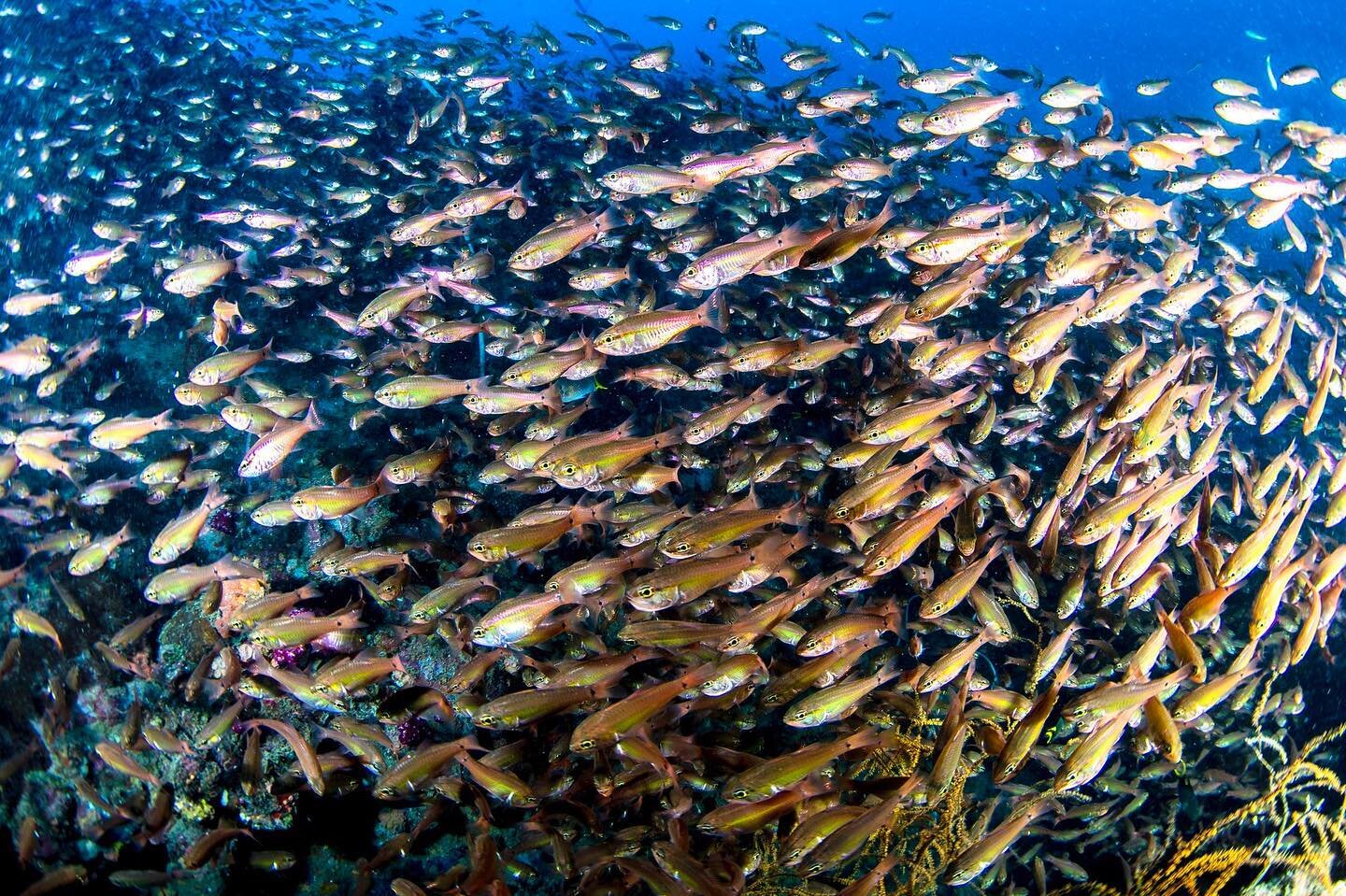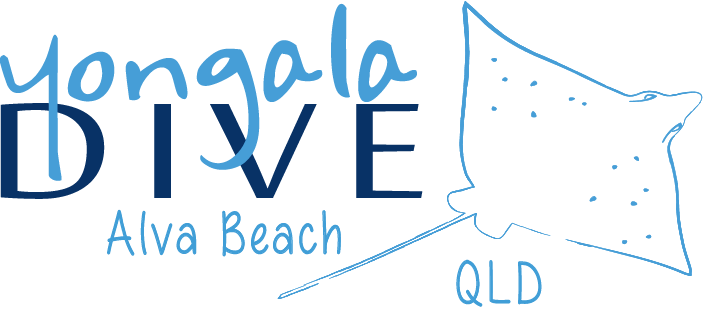
Marine life
Meet the species that call the S.S. Yongala home.
FISH
Maori (Napolean) Wrasse
Cheilinus undulatus
They have a hump on their head between their eyes (becoming larger with age) and thick fleshy lips. Males are bright electric blue to pale green or a dull blue/green while juveniles and females are red-orange above to white below. They prey primarily on crustaceans, molluscs, fish and echinoderms and also on toxic animals such as boxfish and crown of thorns starfish. Adults prefer to occupy more open habitats while juveniles tend to be more in dense branching corals.
Size: Males can reach 2m in length.
Location on the S.S Yongala: Swimming alone or alongside the giant trevally, especially while hunting.
Giant Trevally
Caranx Ignobilis
Also known as Giant Kingfish, Giant Trevally are a species of the jack family. Distinguished by its steep head profile, strong tail scutes and normally a silvery colour, the males may be black at maturity. They inhabit estuaries and shallow bays as juveniles and head to deeper reefs as adults. A powerful predator, giant trevally’s hunt individually and in schools for crustaceans, cephalopods and molluscs. They reproduce in warmer months and reach sexual maturity at around 3 years, or approx. 60cm in length.
Size: A maximum size of 170cm and weighing 80kgs.
Location on the S.S Yongala: Generally cruising around the wreck, often in schools when hunting.
Bull Shark
Carcharhinus leucas
Bull sharks get their name from their short, blunt snout, their pugnacious disposition and a tendency to head-butt their prey before attacking. They are medium-size sharks, with thick, stout bodies and long pectoral fins, grey on top and white below. Their fins have dark tips, particularly on young bull sharks.
Bull sharks are found cruising the shallow, warm waters of all the world’s oceans. Fast, agile predators, they will eat almost anything they see, including fish, dolphins, and even other sharks.
Size: 2.1 to 3.4 m, Weight 90 to 230 kg.
Location on the S.S Yongala: They generally cruise just out of view 20 to 30 metres out from the wreck. Look out from the wreck into the blue to have a chance at spotting them.
Chevron Barracuda
Sphyraena putnamiae
.Barracudas (or’Sea-pikes’) are elongate fishes with a long cylindrical body, pointed snout and protruding lower jaw. Their large mouths are equipped with long sharp edged teeth of unequal size.
They have a silver coloured body with about 20 chevron shaped black bars along the entire body and the caudal fin is dusky with a black margin.
Size: Approximately 90 cm long.
Location on the S.S Yongala: Most likely between the safety stops at 5-10 metres or cruising along the top of the wreck at 15 metres.
Queensland Groper
Epinephelus lanceolatus
Juveniles have a large blotched, banded pattern. As adults they become mottled with evenly dark grey or brownish colour, providing good camouflage for ambush hunting. They have a rounded tail and can extend their mouth to create a strong suction, engulfing unsuspecting food (diver’s beware).
They have a curious nature and will often approach divers at close range. Although not generally considered dangerous, they should be treated with caution.
Size: Giant Queensland gropers are one of the largest of all bony fishes, reaching up to 3m length and about 600kg.
Location on the S.S Yongala: Most likely found at a depth of 15 to 25 metres around the bow.
Moray Eel
Muraenidae
Moray eels are from the family of cosmopolitan eels with approximately 200 species. The body is generally patterned and in some species, the inside of the mouth is also patterned. Their jaws are wide, framing a protruding snout and most possess large teeth used to tear flesh or grasp slippery prey items.
Morays have poor vision and rely mostly on their acute sense of smell making distinguishing between fingers and held food difficult so the hand feeding of moray eels has been banned in some locations, including the Great Barrier Reef. Morays are carnivorous and feed primarily on other fish, cephalopods, molluscs, sea snakes, and crustaceans. Groupers, barracudas, and sea snakes are among their few predators.
Location on the S.S Yongala: Usually hiding in amongst the coral along the hull.
RAYS
Spotted Eagle Ray
Aetobatus narinari
This ray can be identified by its dark dorsal surface covered in white spots or rings. Near the base of the ray’s relatively long tail, just behind the pelvic fins, are several venomous, barbed stingers.
Spotted eagle rays commonly feed on small fish and crustaceans, and will sometimes dig with their snouts to look for food buried in the sand of the sea bed. These rays are commonly observed leaping out of the water. The spotted eagle ray is hunted by a wide variety of sharks.
Size: Spotted eagle rays can reach 3m in width and over 5m in length.
Location on the S.S Yongala: Cruising above and around the wreck, often in schools.
Marble Ray
Taenuira meyeni
The size is the first thing you notice about this ray, often growing to widths bigger than a king size bed! Marble rays are round and flattened in shape and covered with dense dark spots.
Rays are closely related to sharks and have skeletons made of cartilage and exposed gills on their belly. These rays are not aggressive, but care should be taken around the spines on the long tail. They feed on bottom fish and crustaceans using electro-receptors to locate their prey.
Size: Up to 3m in length and 1.7m wide.
Location on the S.S Yongala: Generally cruising around the wreck, often in schools when hunting.
Smalleye Ray
Megatrygon microps
We’re incredibly lucky to often sight the rare smalleye ray on the Yongala. Little is known about these rays, and National Geographic has referred to them as the ocean’s ‘largest, rarest stingray’.
Smalleye rays can be individually identified by the pattern of spots on their back. They make the longest migration of any animal in their family.
Size: It’s wingspan can stretch more than 2m.
Location on the S.S Yongala: Smalleye rays often cruise in out of the blue, and soar over the top of the wreck with an entourage of whiptail rays.
TURTLES
Green Sea Turtle
Chelonia mydas
A large, weighty turtle with a wide, smooth shell. It inhabits tropical and subtropical coastal waters around the world. Unlike most sea turtles, adult green turtles are herbivorous, feeding on sea grasses and algae. Juvenile green turtles, however, will also eat invertebrates like crabs, jellyfish, and sponges.
Green sea turtles are named for the greenish colour of their skin, not the colour of its shell, which is normally brown or olive.
Size: Weighing up to 317 kgs, green sea turtles are among the largest sea turtles in the world.
Location on the S.S Yongala: Generally found feeding or sleeping around the wreck or going to/from the surface to breathe.
Hawksbill Turtle
Eretmochelys imbricata
Hawksbills get their name from their tapered heads, which end in a sharp point resembling a bird’s beak. hawks bills While young, their carapace, or upper shell, is heart-shaped, and as they mature it elongates. Their strikingly coloured carapace is serrated and has overlapping scutes.
A further distinctive feature is a pair of claws adorning each flipper. Male hawksbills have longer claws, thicker tails, and somewhat brighter colouring than females. Like many sea turtles, they are critically endangered, mostly due to human impact. Hawksbills eggs are still eaten around the world, and they are poached for their flesh and stunning shells. Hawksbills are also threatened by accidental capture in fishing nets.
Size: Hawksbills grow up to about 114 cm in shell length and 68kgs.
Location on the S.S Yongala: Generally cruising around the wreck, often in schools when hunting
Loggerhead turtle
Caretta caretta
The largest of all hard-shelled turtles (leatherbacks are bigger but have soft shells) loggerheads have massive heads, strong jaws, and a reddish-brown shell, or carapace.
They are primarily carnivores, munching jellyfish, conchs, crabs, and even fish, but will eat seaweed and sargassum occasionally. Sea turtles can move through the water at speeds of up to 24 km per hour.
Size: Adult males reach nearly one meter in shell length and weigh about 113 kilograms. Large specimens of more than 454 kilograms have been found.
Location on the S.S Yongala: Feeding or sleeping around the wreck or going to/from the surface to breathe.














